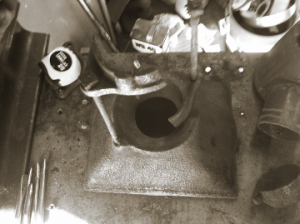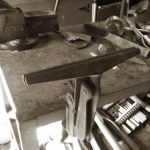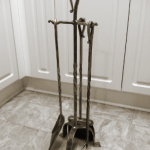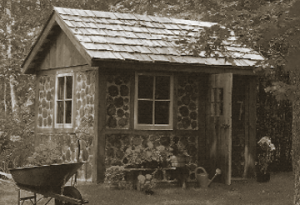This course is designed to acquaint anyone, whether they be architectural historians, collectors, students, curators, conservators, consultants, architects or blacksmiths, in the historic use and conservation of decorative iron in architecture.
Through class room lectures, field trips, demonstrations, discussions and hands on time with artifacts and at the forge, participants will become familiar with the vocabulary of traditional iron details and will develop the ability to ‘read’ an object to describe how it was made, to understand the metallurgical and physical properties of the materials (largely cast iron and wrought iron), and to appreciate the range of options for conservation. Subject matter will range from historic techniques, compatibility of various materials, repair options, galvanic issues, removal of corrosion products and coatings or other forms of protection.
Lloyd Johnston – Blacksmith
Lloyd’s formal education was in engineering. His self directed education and employment over the past 40 years has been in historical metal working technology and conservation. The bulk of his work has been for museums and historic sites in both the public and private sectors in Canada, the United States and Europe. Lloyd is an honourary Life Member of the Ontario Artists’ Blacksmith Association, a member of the Canadian Guild of Arms Historians, the Kentucky Rifle Association, the Council for North eastern Historical Archaeology and the Early American Industries Association.
Lloyd has taught blacksmithing and metal working at public and private Colleges and Universities over the last 25 years. Major commissions include the restoration of 12 Gothic revival gates in the Wellington St. wall on Parliament Hill, the restoration of the Hendry Gates at the Royal Botanical Gardens in Hamilton, and the reproduction of 21 patterns 1837 Brunswick rifles for Fort Wellington NHS in Prescott, Ontario.
Other interests include collecting and conserving historical weapons and stringed instruments. He lives in a fine old stone house in Beaverton Ontario with his historical collection and a Scottish ghost.
Craig Sims – Heritage Building Consultant
Craig has worked in the built heritage field for over 35 years. He has worked successfully with a broad range of clients including government agencies and community groups, but most commonly architects, engineers and contractors who require specialized knowledge. He has developed historic structures reports, historic structure condition surveys, and developed specialized conservation specifications and drawings.
Craig has worked on building types ranging from vernacular log and timber buildings on the prairies to the Parliament Buildings in Ottawa. Some projects of interest include the Rideau Street Convent Chapel in the National Gallery, the Capitol Theatre in Port Hope, Notre Dame Cathedral in Ottawa, the Colonial Building in St. John’s Newfoundland and Fort Henry in Kingston – most are National Historic Sites. He was a consultant, working with Lloyd, for the conservation of the Wellington Wall Gates and is currently involved in the conservation of the roof cresting on both the East & West Blocks on Parliament Hill. Working with Ed recently he was the consultant for the conservation of the Rolph Gates at Dundrun NHS in Hamilton.
Craig is based in Kingston, Ontario. He is a graduate of the Civil Engineering Technology-Restoration Program (1979), St. Lawrence College, and the Technical Education Program (1993), Queens University, Kingston.
Ed Bowkett – Metal Conservator
Ed Bowkett graduated from the Art Conservation Techniques Program at Sir Sandford Fleming College, Peterborough, Ont. in 1994. After being employed by The National Museum of Science and Technology, The Cumberland Museum and a private conservator, he began a private practice. During the past 18 years, Bowkett & Co. has served many institutional and private clients in the Montreal – Toronto. Ed has focused on 3 dimensional objects with a specialization in the treatment of metal artefacts, indoor and outdoor, of all sizes and has provided both treatment and consultation services to The Canadian War Museum, Canadian Conservation Institute, Public Works & Government Services Canada, Parliamentary Precinct Directorate, The Canada Science & Technology Museum, Fulford Place-Brockville, and various from St John’s, NFLD to Saskatoon, SK, and various private clients.
Ed has supervised the daily efforts of student interns on placement from Sir Sandford Fleming College; attends several institutions as a guest lecturer; and guest hosts a CBC phone in show on preservation of antiquities. Ed also continues to be an active volunteer in his community, acting as treasurer and president of the Russell Historical Society; founder and treasurer of Vintage Iron and Traditions, Eastern Ontario; and as a volunteer for The Bytown Railway Society;
This looks like an excellent course, with great instructors! I wish I was able to attend, but if I am to go to Willowbank full-time in September, I need to save my shekels.




You must be logged in to post a comment.